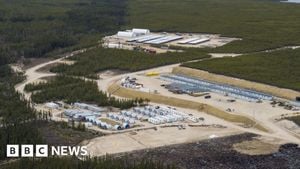Air pollution is once again making headlines, and this time it's shining a light on the often-overlooked consequences for health, particularly related to cancer. Recent research has drawn attention to the links between air pollution exposure and the risks for various cancers, particularly head and neck cancer (HNC). With evidence stacking up, it becomes increasingly important to understand how airborne pollutants contribute to health disparities, especially among marginalized communities.
A study published in Scientific Reports recently outlined a significant correlation between particulate matter (PM2.5) exposure and heightened risk of head and neck cancer. PM2.5 refers to tiny particles smaller than 2.5 microns, which can penetrate deep within the human body, posing serious health risks. The harmful effects of air pollution on various health outcomes, including cancer, have been recognized for quite some time, but studies like this provide more detailed insights.
The findings reveal alarming trends. Higher levels of PM2.5 air pollution show consistent associations with increased risk of HNC across several lag periods. The data stretches back as far as two decades, capturing the long-term effects of pollution exposure. Most startling perhaps is the fact communities already facing significant health challenges are disproportionately affected. The consequences of these findings extend beyond individual diagnosis; they call for targeted public health measures to combat pollution's toll on health.
Notably, cells found within the head and neck region are particularly vulnerable to the risks posed by pollutants and carcinogens. The International Agency for Research on Cancer (IARC) has classified air pollution, especially PM2.5, as a Group 1 carcinogen, indicating it is known to cause lung cancer. This connection expands the risks faced by populations exposed to high levels of smog, smoke, and other pollutants.
Delving beyond general air pollution, the research focused on how these exposures can influence pathways leading to malignancies like squamous cell carcinoma found within the head and neck. Significant contributors to these health disparities include biological agents like human papillomavirus (HPV) and Epstein-Barr virus (EBV), complicatinh the relationship between airborne toxins and cancer incidence.
The study explored multiple layers of data, utilizing sophisticated lag models to sift through information acquired from the Surveillance, Epidemiology, and End Results (SEER) database. Researchers adjusted for various demographic and lifestyle factors, allowing them to isolate the impact of PM2.5 on specific cancer incidences. This nuanced approach reveals how intricately connected our environments are to our health outcomes.
Among the key findings, researchers discovered higher PM2.5 levels consistently correlated with increased risks for HNC across all monitored periods. Notably, the most pronounced association appeared at the five-year lag period, marking approximately a 24% increase in cancer risk. Comparatively, zero and 20-year lag periods revealed smaller, yet significant, increases of 16% and 15% respectively. These figures underline the continuing, though often unrecognized, dangers posed by air pollutants.
Interestingly, the findings did reveal specific cancer subsite associations: increased PM2.5 exposure was markedly linked to oral and throat cancers, but not to others like sinonasal or nasopharyngeal cancers. This indicates varied effects of pollution depending on the type and location of the cancer, which brings more layers to the conversation about environmental health.
Perhaps most impactful is the study's emphasis on vulnerable communities, particularly impoverished and racially diverse groups. These populations encounter higher air pollution levels, leading to advanced stages of HNC at the time of diagnosis. Such discrepancies suggest air pollution compounds pre-existing health inequalities, making it imperative to address these environmental determinants of health.
What does this all mean? The study positions air pollution as a modifiable risk factor for head and neck cancer, accentuating the urgent need for improved air quality. It becomes increasingly clear: public health initiatives targeting pollution could yield significant benefits, particularly for those living in high-risk communities.
To summarize the overarching message from these studies, air pollution emerges as not just a mere annoyance but as a pressing health crisis affecting marginalized populations. The urgent need for action against air pollutants is underscored by the potential positive outcomes of mitigating these risks. Fostering cleaner, healthier air can have ripple effects; reducing cancer incidence could substantially bolster public health outcomes. Continued research and effective policy actions are needed to translate this awareness there is still much to learn about the exact pathways linking air pollution to adverse health outcomes, and even what intervention measures might be most effective.
Addressing these intertwined challenges will not only protect individuals from the threats posed by air pollution but can reshape the very framework of public health and environmental policy moving forward. The converging fields of epidemiology and risk assessment play pivotal roles here, ensuring stakeholders remain informed about the impacts of air pollution on human health.
Through collaboration and data-driven interventions, there's hope for improved health outcomes as societies come together to tackle the overarching challenges of air pollution and its fallout. Efforts need to focus on comprehensive strategies to extinguish these health risks, securing healthier environments for current and future generations.
Stay tuned for more updates as research progresses, shedding light on the confluence of air pollution and human health.



